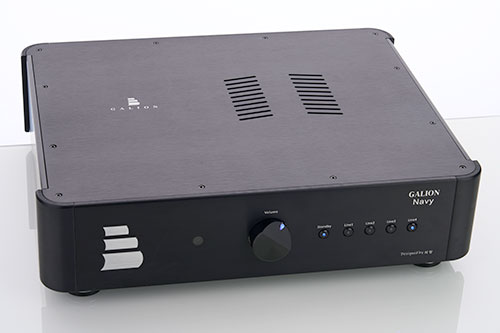
 |
|Ideon Audio 3R USB Renaissance mk2 Black Star, 3R Master Time Black Star, Absolute Time and Absolute Time Signature
This is completely different when transferring digital music data: The data are transmitted in real time. Errors or losses in signal transmission are not corrected due to the design. The USB interface is prone to noise, time errors, and data loss; all things that are particularly critical when transmitting audio data. In addition, there is the annoying 5-volt power supply cable of the USB standard, which is routed very close to the sensitive data signals, but which cannot be easily dispensed with. None of this is new, so it is all the more surprising that even in the case of investments in higher and highest price regions, little attention is sometimes paid to this problem.

And that's where Ideon Audio's re-clockers come in. All four models are designed to compensate for and correct signal degradation on the USB transmission path due to cable loss, poor power supplies and clock errors. The special feature is that it always goes in and out via USB. There is no conversion to another data format, such as S/PDIF or I2S. Ideon addresses the USB vulnerabilities on three levels. The whole thing is then succinctly called 3R and stands for Re-Drive, Re-Clock and Re-Generate.

The core chip, which is used in all four Re-Clocker models, is an individually configurable hi-speed hub controller of the latest generation. Ideon has developed its own firmware for this chip. According to Ideon, signal amplification and correction are implemented in the chip at both the input and output of the re-clocking process (re-drive). In particular, this is intended to minimize the effects of the subsequent USB connection to the DAC. The chip gets its clock signa from a high-precision clock oscillator. This precisely re-clocks the data stream coming from the source, which is intended to minimize jitter in particular. So that there are no misunderstanding: The clock signals have no relation to the audio sample rate frequencies at this point and are not directly involved in the signal conversion. Rather, the USB data stream is re-clocked, which is supposed to make the work of the connected DAC easier.
-
Galion Audio Navy Röhrenvorverstärker
Wir haben das röhrenbestückte Vorverstärker-Flaggschiff Navy des jungen kanadischen HiFi-Unternehmens Galion Audio unter die Lupe genommen. Der Line-Vorverstärker mit vier Doppeltrioden 12AT7 (ECC81) wartet nicht nur mit hochwertigen Bauteilen auf, sondern er ist das spannende Designprodukt eines high-fidelen Überzeugungstäters. Mir sagte der Markenname Galion Audio bislang wirklich gar nichts. Das junge Unternehmen aus Québec in Kanada wurde 2020 von Thomas Tan, einem passionierten Audiophilen, YouTuber („Thomas & Stereo“) und Content Creator, gegründet. Ziel war, seine…16.12.2025 -
Eversolo DAC-Z10
Meine beiden D/A-Wandler, der DAVE im Arbeits- und der HUGO TT2 im Wohnzimmer, werden serienmäßig von Schaltnetzteilen gespeist. Bei letzterem kommt seit einiger Zeit ein Ferrum Hypsos, bei Chord Electronics Topmodell ein lineares Dreifach-Netzteil zum Einsatz. Ein solches versorgt auch den Eversolo DAC-Z10 – zum Preis von 2.000 Euro. Und nein, es sind keine drei ausgelagerten Stromversorgungen, für die der genannte Preis gilt. Dafür bekommt man das vollständige Topmodell unter Eversolos DACs. Es ist schon…09.12.2025 -
Raidho X2.6 Standlautsprecher
Mit Lautsprechern von Raidho haben wir uns bei Hifistatement schon öfter beschäftigt. Im Fokus standen dabei die Kompaktlautsprecher TD1.2 aus der TD-Serie sowie X1t und X1.6. aus der X-Serie. Diesmal haben wir den Standlautsprecher X2.6 zu Gast, das aktuell größte Modell der X-Serie. Raidho verspricht, mit der X-Serie besonders viel Leistung – sprich Klangqualität – für den aufgerufenen Preis zu bieten. Wobei, „billige“ Lautsprecher – ganz gleich nach welchem Maßstab - hat Raidho noch nie…02.12.2025 -
Canor Virtus A3
Zur diesjährigen HighEnd stellte Canor den Virtus A3 Hybrid-Vollverstärker vor. Der lockt mit einem integrierten Digital-Analog-Wandler und einer diskret aufgebauten Phono-Vorstufe für MM- und MC-Tonabnehmer. Sowohl seine Technik als auch die Ausstattung bieten Ungewöhnliches. Vor allem aber soll er klanglich beeindrucken. Das slowakische Entwickler-Team konnte mich bereits vor einem Jahr überzeugen: Der Vollverstärker Virtus I2 aus der Premium Line musizierte in meinem Hörraum wie keiner zuvor in dieser Preisklasse. Der war ein gestandener Röhren-Vollverstärker. Auch…28.11.2025 -
Dan D’Agostino Progression S350
Dan D’Agostino ist eine Legende im Verstärkerbau. Er folgte wohl nie einer Mode, sondern vertraut bei allen Entwicklungen seinem Gehör und seiner Leidenschaft für den guten Klang. Mehr als 50 Jahre baut er nun schon Verstärker, immer mit dem Ziel, das „Wesen der Musik hörbar zu machen“. Erfüllt auch der S350 diese hoch gesteckten Ambitionen? Die Progression S350 ist die kleinste Stereoendstufe im Gesamtprogramm. Optisch trägt sie alle charakteristischen Merkmale einer echten D’Agostino. Angefangen mit…25.11.2025 -
iFi Silent Power USB iPurifier Pro & Pulsar USB
Ohne iFis iDefender+ würde das PC-Audio-Setup in meinem Arbeitszimmer überhaupt nicht störungsfrei funktionieren. Dementsprechend ist es für mich eines der besten Tools im Bereich Computer-Audio. Der iPurifier Pro vereint seine Fähigkeiten mit denen eines iSilencer+ und noch mehr Features in einem Gehäuse. Außerdem teste ich das Pulsar USB-Kabel. iFi ist seit Jahren eine Konstante für hochqualitative Audio-Produkte zu fairen Preisen. Zuletzt wurde die Sparte für Stromversorgung, Kabel und Signal-Verbesserer unter SilentPower zusammengefasst. Noch bevor wir…21.11.2025
© 2025 | HIFISTATEMENT | netmagazine | Alle Rechte vorbehalten | Impressum | Datenschutz











































































































